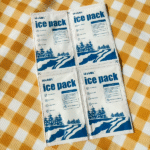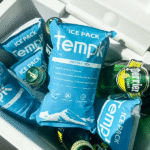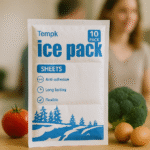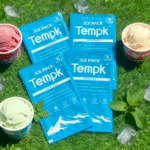Expédition de produits sensibles à la température, des produits pharmaceutiques aux aliments périssables, exige des solutions robustes pour la chaîne du froid. Les blocs de glace sèche sont devenus un élément essentiel de la logistique de la chaîne du froid en raison de leur capacité à maintenir des températures ultra froides sans fuite d'eau.. Ce guide explore comment packs de glace sec optimiser les opérations logistiques et répondre aux tendances émergentes pour 2025. Nous couvrirons les meilleures pratiques, les avantages de la glace carbonique par rapport à la glace traditionnelle, et innovations dans le domaine, vous aidant à rester conforme aux normes de l’industrie et à améliorer votre efficacité.
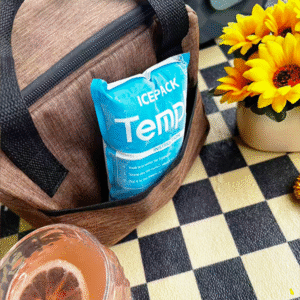
Que sont les packs de glace carbonique et pourquoi sont-ils essentiels pour la logistique de la chaîne du froid?
Les packs de glace carbonique sont du dioxyde de carbone solide (Co₂) qui se subliment à −78,5°C (−109,3 ° F), offrant une température extrêmement froide sans le désordre typique de la fonte des glaces. Ce procédé de sublimation unique leur permet de conserver les produits au froid plus longtemps, garantir l’intégrité des expéditions sensibles à la température comme les produits pharmaceutiques, nourriture, et des échantillons biologiques. Les packs de glace carbonique sont indispensables car ils préviennent les dégâts des eaux, un problème qui peut survenir avec la glace traditionnelle, et ils maintiennent des températures constantes tout au long des longues expéditions.
Principaux à retenir:
-
Pourquoi les packs de glace carbonique sont une solution essentielle pour la logistique de la chaîne du froid
-
Comment choisir le pack de glace carbonique adapté à vos besoins d'expédition
-
Les avantages de l’utilisation de glace carbonique par rapport à la glace traditionnelle dans les opérations de la chaîne du froid
-
Meilleures pratiques pour l'emballage et l'expédition de glace carbonique
-
Tendances émergentes dans la logistique de la chaîne du froid pour 2025
Comment choisir le bon pack de glace carbonique pour votre envoi?
Facteurs à prendre en compte pour la sélection des packs de glace carbonique
Lors de la sélection de blocs de glace sèche pour l'expédition, divers facteurs doivent être pris en compte:
-
Sensibilité à la température: Différents produits nécessitent des gammes de températures différentes. Par exemple, les produits pharmaceutiques et les vaccins nécessitent souvent des températures ultra-basses, et la glace carbonique est idéale pour ces expéditions sensibles.
-
Durée de l'expédition: Plus l'expédition est longue, plus vous aurez besoin de glace carbonique. Une directive générale est 1-2 livres de glace carbonique par 24 heures pour des expéditions plus courtes, et plus pour les plus longs.
-
Taille et poids de l'envoi: Les expéditions plus importantes nécessitent plus de neige carbonique. Il est essentiel de calculer la bonne quantité pour garantir que l'envoi maintient la température requise..
| Type d'expédition | Quantité recommandée de glace carbonique | Durée d'expédition | Plage de température |
|---|---|---|---|
| Expéditions pharmaceutiques | 5–10 livres par 24 heures | 24–72 heures | -20° C à -70 ° C |
| Expéditions de fruits de mer | 1–2 livres par 24 heures | 24 heures | -18° C à -20 ° C |
| Échantillons de biotechnologie | 5 lbs par 24 heures | 48 heures | -20° C à -50 ° C |
| Livraisons de nourriture | 2–3 livres par 24 heures | 24 heures | -10° C à -18 ° C |
Quels sont les avantages de l'utilisation de la glace carbonique par rapport à la glace traditionnelle dans la logistique de la chaîne du froid?
Durée de refroidissement prolongée
La glace carbonique reste froide beaucoup plus longtemps que la glace traditionnelle, ce qui le rend idéal pour les expéditions qui doivent rester fraîches pendant de longues périodes. Contrairement à la glace ordinaire, qui fond et nécessite un réapprovisionnement fréquent, la glace carbonique peut maintenir les marchandises à la température requise pendant de longues périodes d'expédition.
Aucune fuite d'eau
Un avantage important de la neige carbonique est sa capacité à se sublimer directement en gaz., évitant le problème de fuite d'eau qui se produit souvent avec la glace traditionnelle. Ceci est particulièrement critique lors de l’expédition de produits délicats tels que des échantillons biotechnologiques et des produits pharmaceutiques., où tout contact avec l'eau peut endommager les marchandises.
Contrôle de la température en dessous de zéro
Pour les produits qui nécessitent des températures inférieures à zéro, la neige carbonique est souvent la seule option réalisable. Il est idéal pour la conservation à très basse température, fournissant un refroidissement fiable pendant des durées prolongées. Cela le rend essentiel pour des industries comme la biotechnologie et les produits pharmaceutiques., où le contrôle de la température est essentiel à l’efficacité du produit.
Meilleures pratiques d'emballage et d'expédition avec des packs de glace carbonique
Optimiser l’efficacité des blocs de glace carbonique dans la logistique de la chaîne du froid, Suivez ces meilleures pratiques:
Utiliser des conteneurs isolés
Une bonne isolation aide à maintenir la température froide à l’intérieur du récipient et ralentit le processus de sublimation. Pour les expéditions à court terme, les glacières en mousse ou les boîtes isothermes conviennent. Pour les expéditions plus longues, les conteneurs avancés isolés sous vide offrent une protection thermique supérieure, aidant à prolonger la durée de refroidissement.
Superposez correctement la glace carbonique
La glace carbonique doit être placée au fond du récipient. Cela garantit que l'air froid monte et refroidit efficacement les produits.. Il est essentiel de laisser de la place au gaz CO₂ pour s’échapper afin d’éviter toute accumulation de pression à l’intérieur du conteneur..
Surveiller la température pendant le transit
L’utilisation de capteurs de température compatibles IoT permet une surveillance en temps réel de la température de l’envoi. Cela garantit que toute fluctuation de température est immédiatement prise en compte, prévenir la détérioration et garantir le respect des exigences réglementaires en matière de température.
2025 Tendances de la logistique de la chaîne du froid
Emballages intelligents et capteurs IoT
Dans 2025, la logistique de la chaîne du froid est transformée par les progrès de l'emballage intelligent. Les capteurs IoT intégrés aux blocs de glace carbonique fournissent des données en temps réel sur la température, humidité, et emplacement, s'assurer que les expéditions restent dans la plage de température souhaitée. Ces technologies réduisent le risque de détérioration et améliorent l’efficacité, en particulier dans les expéditions longue distance et internationales.
Focus sur la durabilité
Alors que les préoccupations environnementales deviennent de plus en plus importantes, l'industrie de la chaîne du froid s'oriente vers des solutions d'emballage durables. Les entreprises adoptent de plus en plus de matériaux biodégradables et recyclables pour réduire leur empreinte carbone tout en garantissant que les produits sensibles à la température sont transportés en toute sécurité..
Aperçus du marché et projections de croissance
Le marché mondial de la logistique de la chaîne du froid devrait connaître une croissance substantielle, motivée par la demande croissante de produits pharmaceutiques, biologique, et produits alimentaires sensibles à la température. Par 2025, Le marché devrait atteindre $500 milliard, avec une croissance significative alimentée par les innovations dans les matériaux d’emballage, y compris des emballages intelligents et des solutions respectueuses de l'environnement.
FAQ
De quelle quantité de glace carbonique ai-je besoin pour un envoi en 24 heures?
Pour une expédition 24h / 24, vous aurez généralement besoin de 5 à 10 livres de neige carbonique, en fonction de l'isolation et de la température ambiante. Pensez toujours à ajuster en fonction des besoins spécifiques de votre envoi pour éviter les écarts de température..
Les packs de glace carbonique sont-ils sûrs à manipuler?
Oui, la glace carbonique peut être manipulée en toute sécurité lorsque les précautions appropriées sont prises. Portez toujours des gants isolés, Assurer une bonne ventilation, et respecter toutes les règles d'étiquetage et de sécurité, y compris le « Dioxyde de Carbone, Label « solide ».
La glace carbonique peut-elle être utilisée pour expédier des articles réfrigérés?
La glace carbonique est généralement utilisée pour les articles surgelés, mais pour les produits réfrigérés (2° C - 8 ° C), les alternatives telles que les packs de gel ou les matériaux à changement de phase sont mieux adaptées pour maintenir la plage de température appropriée sans geler le produit.
Conclusion et recommandations
Les packs de glace carbonique restent la pierre angulaire de la logistique de la chaîne du froid, fournir des, rentable, et des solutions écologiques pour les expéditions sensibles à la température. En choisissant la bonne solution de glace carbonique, suivre les meilleures pratiques, et garder un œil sur les dernières tendances de l'industrie, les entreprises peuvent assurer le transport sûr et efficace des marchandises périssables dans 2025 et au-delà.
Conseils exploitables:
-
Évaluez vos besoins d’expédition: Déterminez si vous avez besoin de glace carbonique, packs de gel, ou des matériaux à changement de phase en fonction du type de produit et de la durée d'expédition.
-
Investissez dans un emballage intelligent: Gardez une longueur d'avance grâce à des emballages et des capteurs compatibles IoT pour la surveillance de la température en temps réel.
-
Optez pour des solutions durables: Envisagez des packs de glace carbonique réutilisables et des emballages respectueux de l'environnement pour réduire votre empreinte carbone et améliorer vos pratiques de développement durable..
À propos du tempk
Tempk se spécialise dans la fourniture de solutions avancées de chaîne du froid pour diverses industries, y compris les produits pharmaceutiques, nourriture, et biotechnologie. Nos produits, allant des blocs de glace carbonique aux solutions d'emballage intelligentes, sont conçus pour garantir un contrôle optimal de la température., conformité réglementaire, et durabilité. Nous vous aidons à livrer vos produits sensibles à la température avec fiabilité, efficacité, et un impact environnemental minimal.
Pour une solution logistique sous chaîne du froid sur mesure, contactez notre équipe d’experts dès aujourd’hui!
















